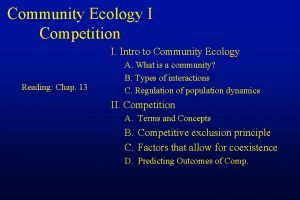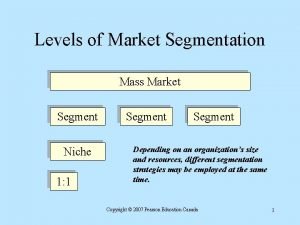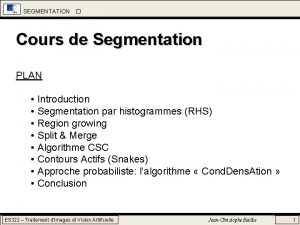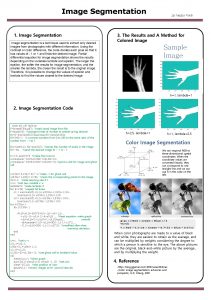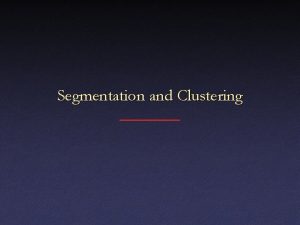Levels of Market Segmentation Mass Market Segment Niche



















- Slides: 19

Levels of Market Segmentation Mass Market Segment Niche 1: 1 Segment Depending on an organization’s size and resources, different segmentation strategies may be employed at the same time. Copyright © 2007 Pearson Education Canada 1

Mass Marketing “One basic marketing strategy appealing to a broad range of consumers, not addressing any distinct characteristics among the consumers. ” Wal-Mart Copyright © 2007 Pearson Education Canada 2

Market Segmentation “Dividing a large market (mass market) into smaller homogeneous markets (segments) based on common needs and / or similar lifestyles. ” Copyright © 2007 Pearson Education Canada 3

Niche Marketing to subgroups within a segment where there is less competition. Beer Segments Premium Beers Mainstream Beers Value Beers Sleeman’s directs all resources at the premium niche. They grew when beer drinkers shifted from mainstream beers to craft beers. Copyright © 2007 Pearson Education Canada 4

Direct (1: 1) Segmentation “Unique marketing programs are designed to meet the needs and preferences of individual customers. ” § Database management techniques § Mass customization § Customer relationship management § Direct communications Copyright © 2007 Pearson Education Canada 5

Selecting Targets Segmentation involves three essential steps: 1. Identifying market segments 2. Selecting segments with the greatest potential $ $ $ 3. Positioning product to appeal to target. Copyright © 2007 Pearson Education Canada 6

Identifying Target Markets Targets are identified based on certain characteristics. Demographic Psychographic Geographic Behaviour Response What emerges is a target market profile; a portrait of the ideal consumer. Copyright © 2007 Pearson Education Canada 7

Demographic Segmentation Characteristics Age Gender Income Occupation Education Marital Status Household Formation Ethnic Background Marketers monitor demographic trends and adjust marketing strategies appropriately. Copyright © 2007 Pearson Education Canada 8

Age Segments § Canada’s population is aging § Generation Y to become a powerful buying group § Retaining older customers while attracting new customers is a challenge Youth Generation Y Generation X Baby Boomers Greys Copyright © 2007 Pearson Education Canada 9

Gender Targeting 1. Influence of women in decision-making is underestimated by many organizations. 2. Men are reinventing themselves (personal care). 3. Gender stereotyping should be avoided. Need to communicate more intelligently. 4. Changing roles leads to “unisex” targeting. Copyright © 2007 Pearson Education Canada 10

Ethnic Targeting 1. 13. 4% of population are visible minorities (43% in Toronto). 2. Accessible market niches in Toronto, Montreal and Vancouver. 3. Ethnic-inspired products and communications have an impact. Copyright © 2007 Pearson Education Canada 11

Geographic Segmentation Distinct geographic regions present challenges for marketers. • Language • Culture • Urban • Suburban • Rural • Geodemographics Regional opportunities must be assessed (costs versus benefits). Unique needs may necessitate micromarketing strategies. Copyright © 2007 Pearson Education Canada 12

Psychographic Segmentation “Identifying a target based on the activities, interests, and opinions (the lifestyle) of consumers. ” When lifestyle considerations are included demographic segments are quite different. Axe deodorant was launched solely on the basis of psychographic profiling of young males. Copyright © 2007 Pearson Education Canada 13

Behaviour Response Segmentation Behavioural influences are considered along with other segmentation variables. Ø Occasion for use Ø Benefits Sought Ø Usage Rate Ø Loyalty Response Copyright © 2007 Pearson Education Canada 14

Market Segmentation Strategies Market Differentiation Operate in many segments, with many products with unique marketing strategies. Niche Marketing All resources aimed at a distinct segment. QTG Canada (Quaker Tropicana Gatorade) is a differentiator; TSN (The Sports Network) is a nicher. Copyright © 2007 Pearson Education Canada 15

Market Segmentation Strategies Market Integration A company expands from a segment to embrace other similar segments The battle for customers today is very intense. Integrators don’t stand still; they respond to new needs. • Wal-Mart adds groceries • Loblaw and other supermarkets add pharmacies Copyright © 2007 Pearson Education Canada 16

Positioning “The place a brand occupies in the customer’s mind in relation to competing products. ” Positioning involves a 2 -Step Process: 1. Develop and market a product that meets needs. 2. Create appropriate appeals to differentiate the product in the customer’s mind. Copyright © 2007 Pearson Education Canada 17

Positioning Strategies 1. Head-on 2. Brand Leadership 3. Product Differentiation 4. Innovation 5. Lifestyle Copyright © 2007 Pearson Education Canada 18

Repositioning “Changing the place a product occupies in the consumer’s mind. ” Repositioning is due to: 1. The activity of a direct competitor. 2. The preferences of a target market change. Cadillac reinvented itself. It’s no longer grandpa’s car! Copyright © 2007 Pearson Education Canada 19
 Can a realized niche be larger than a fundamental niche
Can a realized niche be larger than a fundamental niche Resource partitioning example
Resource partitioning example Mass marketing and niche marketing
Mass marketing and niche marketing Market segmentation market targeting and market positioning
Market segmentation market targeting and market positioning Mass market segmentation
Mass market segmentation Segment by segment invasion
Segment by segment invasion Arsitektur komunikasi satelit
Arsitektur komunikasi satelit Horse niche market
Horse niche market Niche market prevod
Niche market prevod Segmentation levels
Segmentation levels Level 3 questions examples for avid
Level 3 questions examples for avid Leader follower challenger nicher
Leader follower challenger nicher Geographic segmentation of cadbury
Geographic segmentation of cadbury Market segment template
Market segment template Kfc segmentation targeting positioning
Kfc segmentation targeting positioning Segmentation bases
Segmentation bases Nivea target market
Nivea target market What are the requisites of sound market segmentation
What are the requisites of sound market segmentation Pringles target demographic
Pringles target demographic Bases of market segmentation
Bases of market segmentation
